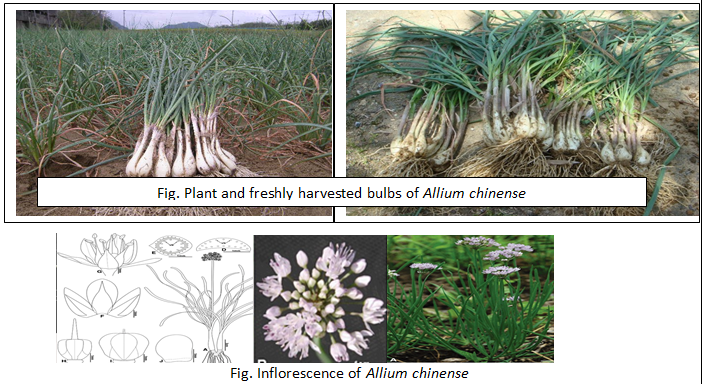Authors: T. Chamroy
Correspondence address: tchamroy@gmail.com
Allium chinense
Family: Amaryllidaceae
Common names:
Allium chinense is also commonly known as Chinese onion, Chinese scallion, Japanese scallion, Kiangsi scallion, oriental onion and Rakkyo.
Distribution:
Allium chinense is native to China. It is found mainly in the tropical and sub-tropical areas of Japan, China and many other parts of eastern Asia. In Asia, it is popularly cultivated as a vegetable for its bulbs and leaves. It is known to be cultivated in some parts of North-Eastern regions of India as well.
Botanical description: Allium chinense is biennial herb producing a cluster of leaves 15-35 cm long and flowering scape 20-40 cm tall from an underground bulb.
Bulb ellipsoidal at top gradually tapering into the leaf-blades; protective bulb-coat leaves several, membranous, white to purplish and 4-5 cm in diameter.

Inflorescence umbellate, 6-30-flowered, without bulbils; spathe 2-lobed, persistent, hyaline; pedicel 1-3 cm long; flowers campanulate, purplish, tinged with red; tepals 6 in 2 whorls, 4-5 mm long; stamens 6, much longer than the tepals; inner 3 filaments with broadened bases and each with 2 short teeth; pistil much longer than the tepals; ovules 2 per locule.
Growth and development: After planting, the growing point of a bulb divides to form a cluster of sprouting shoots and the number and weight of roots and leaves increase rapidly. After the shoots have reached a certain size, bulbs are formed, and the leaves wither and die. At intermediate latitudes (30-40 °N and S), the flower stalk develops inside the bulb during the summer period, and in late summer the scape grows out of the old bulb whose leaves, by then, have already withered. The scape appears to stand outside the leaves as those are formed on new lateral bulbs. Since the flowers are female sterile, no seeds are produced. In the tropics, the full-grown crop remains small and development phases are much less pronounced than at intermediate latitudes; flowering is very rare in the tropics.
The bulb resembles a small onion, but the bulb is formed by the thickened leaf-sheaths only and no bladeless scales are formed like those in the onion; consequently, no thin neck occurs.
Composition: It contains about water 86 g, 3.1 g protein, fibre 0.3 g, 0.12 g fat, 18.3 g soluble carbohydrate and 0.7 g ash per 100 g of fresh bulb. The energy value is 215 kJ/100 g.
Uses:
- Edible uses
- Medicinal uses
Allium chinense contains sulphur compounds and when added to the diet on a regular basis will help reduce blood cholesterol levels, acts as tonic to the digestive system and also tonify the circulatory system.
- Other uses The juice of the plant is used as a moth repellent. The whole plant is said to repel insects and moles.
Soil and climate: The climatic requirement of Allium chinense is not well known. However, Long days (16 hours) promote bulb and flower formation. The plant requires a sunny position for its growth and cannot grow in the shade. However it requires a cool climate as it often die-back in hot and dry weather during mid-summer. The optimal temperature range for bulb formation is 15-25 °C. Photosynthesis decreases when the temperature increases from 15 °C to 35 °C, whereas transpiration increases. It is resistant to drought and can be grown without irrigation, but watering in dry months considerably increases yield. It thrives well in a light well-drained sandy - loamy soil. It prefers a moist soil condition, pH ranging from acid, neutral and basic.
Propagation and planting: A. chinense is always propagated vegetatively by bulbs which are planted after a storage period of 1-2 months to overcome dormancy. Plants are usually spaced 10-15 cm × 10-15 cm.
In North-Eastern regions of India the bulbs of previous season are generally used as propagating material. Planting is done directly in the field, commencing from February till April when the soil is moist and weather is cool.
Harvesting and yield: A. chinense can be harvested from 60-90 days after planting. Harvesting is by hand, and bulbs are sold fresh in small bundles. Yields of 15-20 t/ha have been reported in Japan, but are much lower in the tropics.
Problems: Chlorosis is one of the major physiological disorder of A. chinense caused by zinc deficiency; the symptoms are yellowish stunted plants with thickened leaves and distorted new leaves. Foliar applications of zinc sulphate can reduce the damage. The only pest reported is the Rhizoglyphus mite.
Genetic resources and breeding: Farmers' selections seem to be the only genetic resources available for further improvement. Collection of wild types has not yet been done. Breeding does not seem to be very urgent. An array of cultivars is available in China, Japan and parts of north-east regions in India, but they do not set seed, since most cultivars are sterile tetraploids. Finding seed-producing selections could signal a breakthrough, as in garlic.
References
- GRIN (2011). “Allium chinense information from NPGS/GRIN.” Taxonomy for plants. National Germplasm Resources Laboratory, Beltsville, Maryland: USDA, ARS, National Genetic Resources Program.
- Multilingual Multiscript Plant Name 'Database (2014): Allium. University of Melbourne.
- Plants for a future: Allium chinense
- Useful tropical plants database 2014.
- Q.P. van der Meer & L. Agustina ; Diah Sulistiarini, Juliasri Djamal & Iman Raharjo (2016). Allium chinense (PROSEA). Plant resources of South-East Asia. http://uses.plantnet-project.org
About Author / Additional Info:
Presently working as an Assistant Professor in Division of Horticulture
Lovely Professional University, Jalandhar, Punjab